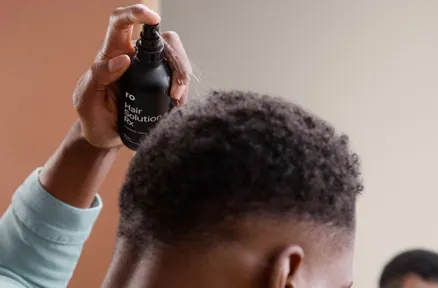Traction alopecia: causes, treatment, prevention

Reviewed by Gina Allegretti, MD,
Written by Chimene Richa, MD
last updated: Dec 03, 2021
3 min read
Here's what we'll cover
Alopecia, or hair loss, has many different causes, one of which is pulling on the hair repeatedly over a long period of time. This type of alopecia is known as traction alopecia, and it can be brought on by things like wearing your hair in tight braids or a tight ponytail.
Let’s learn more about this particular type of hair loss.
What is traction alopecia?
As we covered above, traction alopecia is a hair loss that occurs when your hair is repeatedly pulled on. Health professionals started to take notice of traction alopecia in the early 1900s when women in Greenland who wore their hair in tight ponytails lost their hair over time, but women who wore their hair loosely did not.
Over the years, these tight, often dubbed “traumatic,” hairstyles have been implicated as the most significant risk factors for this condition. It can affect anyone who wears certain hairstyles, especially if chemical relaxants are used simultaneously (Billero, 2018).
Symptoms of traction alopecia
In traction alopecia, you’ll usually see patches of hair loss in the areas of the scalp under the most tension. It depends on the shape of the hairstyle, but it’s often seen at the hairline or above the temples (Akingbola, 2017).
In the early stages of traction alopecia, you may see broken hairs and redness around hair follicles (cells that produce each hair) at the base of each hair shaft. As traction alopecia progresses, you can develop inflammation of the hair follicles (folliculitis), leading to pimples or tension bumps on the scalp.
And as the condition worsens, you may experience tenderness, itching, or ulcers on the scalp. In advanced cases, you can develop irreversible scalp scarring that leads to decreased hair growth, hair thinning, and potentially permanent hair loss in those areas (Akingbola, 2017).
What causes traction alopecia?
Traction alopecia is a result of repeated and longstanding trauma to hair follicles. Tight hairstyles can damage hair follicles, causing inflammation and leading to hair loss over time.
The hairstyles with the highest risk of causing traction alopecia are (Akingbola, 2017):
Tight braiding: these can be sectioned braids, braids with plastic beads attached, or form cornrows
Hair extensions or weaves
Dreadlocks
Tight buns or ponytails, like those worn by ballerinas
Turban use: the hair is tied in a tight ponytail, and then the head is wrapped tightly with a turban, as is common in the Sikh community (James, 2007)
Traction alopecia occurs in one-third of women of African descent who wear these tight hairstyles. Additionally, using chemical “relaxers” with any of these hairstyles increases the risk of traction alopecia because the relaxed hair is weaker and more brittle (Billero, 2018).
Traction alopecia treatment
If you think you have traction alopecia, see a dermatologist who treats hair loss. Your provider may perform additional testing to confirm the diagnosis, such as trichoscopy (examining the hair and scalp under high magnification) or a scalp biopsy (removing a small piece of scalp tissue for microscopic evaluation). A biopsy may rule out other conditions that mimic traction alopecia, including (Billero, 2018):
Trichotillomania: an impulse-control condition where you cannot stop pulling your own hair, usually on your scalp but sometimes from other places on your body. This causes broken hairs in the thinning patches.
Scarring alopecia is a type of alopecia in which inflammation kills the hair follicles, replacing them with scar tissue, leading to baldness. Several skin disorders can cause this, including folliculitis and lupus.
Alopecia areata: an autoimmune condition where the body attacks its own hair leading to sometimes patchy hair loss (NAAF, n.d).
If your healthcare provider determines that your hair loss is due to traction alopecia, treatment depends on how much this type of hair loss has progressed.
Can traction alopecia be reversed?
Most cases of traction alopecia can be reversed by removing the source of the traction if they are caught early. Unfortunately, if you wait until it reaches the scarring hair loss stage, treatment may not be successful (Billero, 2018).
Applying steroid creams can help reduce inflammation and prevent scarring during the early folliculitis stages. There are reports of people having hair regrowth after using topical minoxidil (brand name Rogaine) for several months, but more research is needed in this area. A hair transplant or hair plugs may be an option In later stages where you have had scarring and follicle loss (Billero, 2018).
Oral Minoxidil Important Safety Information: Read more about serious warnings and safety info.
How to prevent traction alopecia
The best way to prevent traction alopecia is to adopt certain hair care practices that avoid putting tension on your hair whenever possible. Try to avoid tight hairstyles when possible. If they cannot be avoided, limit their use and wear your hair loose whenever you can. Change your hairstyles regularly so that the tension is not always on the same part of the scalp. And try to limit the use of chemical hair care products and relaxers, especially if you need to wear a tight hairstyle.
DISCLAIMER
If you have any medical questions or concerns, please talk to your healthcare provider. The articles on Health Guide are underpinned by peer-reviewed research and information drawn from medical societies and governmental agencies. However, they are not a substitute for professional medical advice, diagnosis, or treatment.
Akingbola, C. O. & Vyas, J. (2017). Traction alopecia: A neglected entity in 2017. Indian Journal of Dermatology, Venereology, and Leprology, 83 (6), 644–649. doi: 10.4103/ijdvl.IJDVL_553_16. Retrieved from https://pubmed.ncbi.nlm.nih.gov/29035284/
Billero, V., & Miteva, M. (2018). Traction alopecia: the root of the problem. Clinical, Cosmetic and Investigational Dermatology , Volume 11 , 149–159. doi: 10.2147/ccid.s137296. Retrieved from https://pubmed.ncbi.nlm.nih.gov/29670386/
James, J., Saladi, R. N., & Fox, J. L. (2007). Traction alopecia in Sikh male patients. The Journal of the American Board of Family Medicine, 20 (5), 497-498. Retrieved from https://pubmed.ncbi.nlm.nih.gov/17823469/
National Alopecia Areata Foundation (NAAF). (n.d.). Alopecia Areata . Retrieved Oct. 3, 2019 from https://www.naaf.org/alopecia-areata










